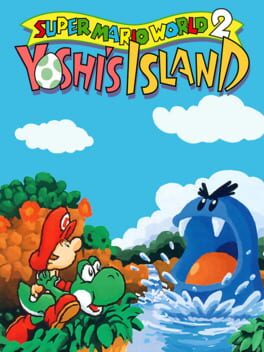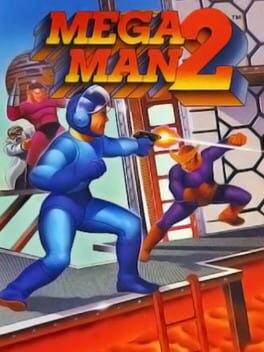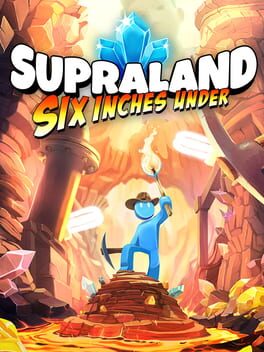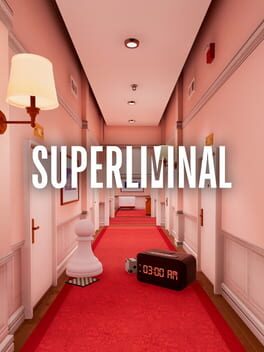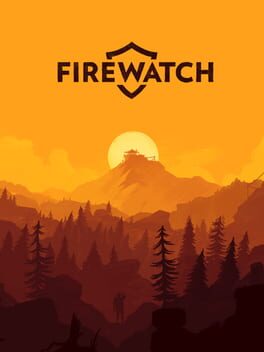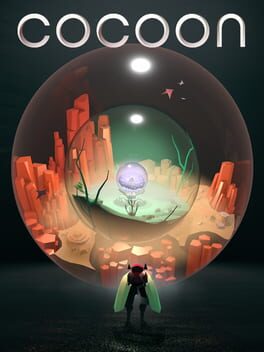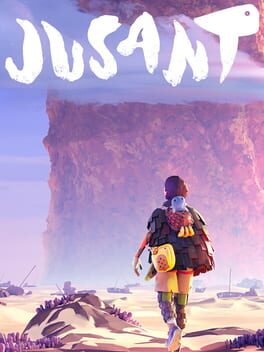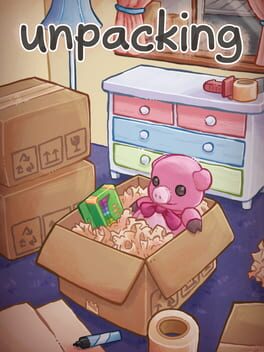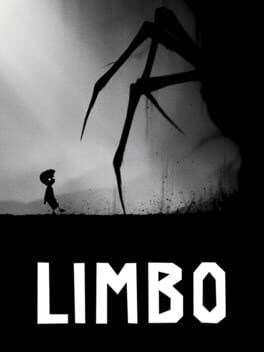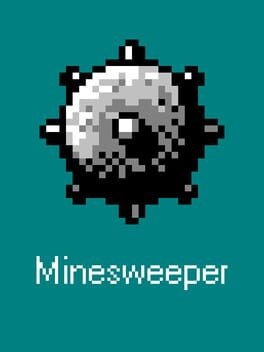RenegadeRadish
Super Mario World 2: Yoshi's Island fully utilized the SNES's hardware to completely achieve its goal as a happy and lovely 2D platformer featuring expansive levels with lots of secrets to find.
As with most other SNES games, Yoshi's Island features gorgeous pixel art. The lack of major color restraints enables the picture book aesthetic to pop. Sprites feature plenty of fun and stretchy animations thanks to Mode 7. Often times, graphical elements will be stretched, rotated, transparent, and other adjectives thanks to the SNES's graphics power. Certain objects are 3D sprites going into and away from the foreground. I never found the use of Mode 7 as "forced" to show off the SNES power though. They all were neat effects that had some interesting gameplay implication.
The original Yoshi's Island OST avoids the campy, artificial happy feeling that the later Yoshi soundtracks fell victim to. They're happy, lovely, feel good songs but they don't forcefully grab your mouth to pretend you're smiling. I believe the lack of high quality sampling on the SNES prevented Koji Kondo from incorporating annoying instruments into the compositions. The other Yoshi soundtracks could be improved simply by changing the instrumentation. Rant aside, the game does use all of the SNES's sound channels to achieve its full arrangements, meaning when sound effects must be played, parts of the music cut out. To me, I hardly ever noticed parts of the song popping in and out, but it does slightly take away from the in-game music experience. Overall though, the Yoshi's Island OST is one of the SNES's best and one of Koji Kondo's best pieces of work.
Yoshi's Island feels like a modern 2D-platformer with an emphasis on expansive levels with lots of collectibles. Each level features a specific theme and runs through the usual process of introducing a mechanic and running that mechanic through multiple scenarios with increasing difficulty. The level gimmicks are mostly fun, with a few mediocre/boring ones (I didn't enjoy ice or mud). The game features lots of strange friendly and hostile creatures. The monkeys and penguins are so cute and silly (while also being serious threats to baby Mario). A lot of the enemies are shy guy variants, but those variants feel distinct and do not blend together, as many of the modern Mario enemy variants tend to do. The bosses are all bigger versions of normal enemies, but each boss interacts with the player differently from the normal variant, making this not an issue.
Yoshi's controls are solid. Throwing eggs feels good once you enable to releasing to throw. Hitting targets is some fun dopamine. The flutter jump was useful, but the slowing of movement while fluttering contributed to overall slower pace of the game. The lack of a run button also points towards the slower pace.
When Yoshi takes damage, Baby Mario falls off and you have to grab him before your stars run out. The whining is god awful annoying, so I turned it off half-way through my playthrough via cheats. Dying results in losing all the collectibles you gathered since the last checkpoint, but if you take your time through the levels, you won't die. I did not take my time, so I died too many times and lost a lot of progress due to impatience.
I believe Yoshi's Island is meant to be played at a slower pace, carefully scouring the stages for all the collectibles. If you prefer platformers to be semi-fast or faster paced and emphasize tight platforming rather than exploration, this game may not be "ideal" for you. It's still a lovely game that I certainly enjoyed my time playing, but I think a casual gamer would find it more fun than I did.
As with most other SNES games, Yoshi's Island features gorgeous pixel art. The lack of major color restraints enables the picture book aesthetic to pop. Sprites feature plenty of fun and stretchy animations thanks to Mode 7. Often times, graphical elements will be stretched, rotated, transparent, and other adjectives thanks to the SNES's graphics power. Certain objects are 3D sprites going into and away from the foreground. I never found the use of Mode 7 as "forced" to show off the SNES power though. They all were neat effects that had some interesting gameplay implication.
The original Yoshi's Island OST avoids the campy, artificial happy feeling that the later Yoshi soundtracks fell victim to. They're happy, lovely, feel good songs but they don't forcefully grab your mouth to pretend you're smiling. I believe the lack of high quality sampling on the SNES prevented Koji Kondo from incorporating annoying instruments into the compositions. The other Yoshi soundtracks could be improved simply by changing the instrumentation. Rant aside, the game does use all of the SNES's sound channels to achieve its full arrangements, meaning when sound effects must be played, parts of the music cut out. To me, I hardly ever noticed parts of the song popping in and out, but it does slightly take away from the in-game music experience. Overall though, the Yoshi's Island OST is one of the SNES's best and one of Koji Kondo's best pieces of work.
Yoshi's Island feels like a modern 2D-platformer with an emphasis on expansive levels with lots of collectibles. Each level features a specific theme and runs through the usual process of introducing a mechanic and running that mechanic through multiple scenarios with increasing difficulty. The level gimmicks are mostly fun, with a few mediocre/boring ones (I didn't enjoy ice or mud). The game features lots of strange friendly and hostile creatures. The monkeys and penguins are so cute and silly (while also being serious threats to baby Mario). A lot of the enemies are shy guy variants, but those variants feel distinct and do not blend together, as many of the modern Mario enemy variants tend to do. The bosses are all bigger versions of normal enemies, but each boss interacts with the player differently from the normal variant, making this not an issue.
Yoshi's controls are solid. Throwing eggs feels good once you enable to releasing to throw. Hitting targets is some fun dopamine. The flutter jump was useful, but the slowing of movement while fluttering contributed to overall slower pace of the game. The lack of a run button also points towards the slower pace.
When Yoshi takes damage, Baby Mario falls off and you have to grab him before your stars run out. The whining is god awful annoying, so I turned it off half-way through my playthrough via cheats. Dying results in losing all the collectibles you gathered since the last checkpoint, but if you take your time through the levels, you won't die. I did not take my time, so I died too many times and lost a lot of progress due to impatience.
I believe Yoshi's Island is meant to be played at a slower pace, carefully scouring the stages for all the collectibles. If you prefer platformers to be semi-fast or faster paced and emphasize tight platforming rather than exploration, this game may not be "ideal" for you. It's still a lovely game that I certainly enjoyed my time playing, but I think a casual gamer would find it more fun than I did.
I will be going back to complete more of Symphony of the Night, but I particularly enjoyed the later two thirds of this initial playthrough.
The PS1 had enough power to produce pixel art with few limitations, which made the choice to use pixel art feel like a fleshed out artistic decision rather than a result of hardware limitations. I liked the moments the game featured 3D models or more advanced visual effects such as the save icosahedron and coffin and clouds in the background. They were cool uses of the PS1's more advanced hardware, akin to what Yoshi's Island did on the SNES's mode 7. The parallax scrolling gave the detailed and varied backgrounds a good sense of depth. I particularly recall the outdoor areas, the underground catacombs, and the library. Alucard's walk cycle and trail effect mesmerized me and were certainly my favorite part of the game's visuals.
Symphony of the Night was a blessing to my ears. All the parts of the castle had a unique track to them, and with CD quality audio, these tracks have nothing holding them back from their true sound. I appreciate the variety of styles each location had. The coliseum had a cool beat. My favorite would probably be the main castle theme since I heard it the most and will recognize it anywhere now.
The first 1-3 hours didn't quite hook me so hard. I got a lot of upgrades for my stats, which did lead to some feeling of progression, but not as well as other games of this style. Once I reached the rightmost side of the castle though, the game really began providing new abilities which would enable access to more parts of the castle. That Super Metroid style of progression is what made me love the final two thirds my playthrough, since it seemed like I was a cool vampire exploring Dracula's Castle with fitting music. There were a few bits about the gameplay throughout the whole journey that bugged me. After having played Hollow Knight, the sword combat felt clunky at first, with the inability to swing above or below. The movement didn't have much speed to it aside from the dodge, which I spammed throughout my whole journey. Having to reacquire items after dying got annoying, although this is an issue that many games from this era feature, including Super Metroid. Lastly the classic Castlevania items were each fun to use, but I would've much preferred having them as permanent upgrades to your moveset. I dislike having access to only one of these combat abilities, since it made me fall back exclusively on the sword over all else.
Despite all my nitpicks though, this was still a good execution of Zelda-like progression in a 2D space. The RPG and classic Castlevania elements may not have been my favorite, but I still had a ton of moments I loved in this game and I'm glad I played this classic. I would recommend this game to anyone who enjoyed any other Metroidvania. I don't think it's an essential play if you haven't played a Metroidvania, but if you have and know you enjoy item-gated progression, then this game has that but with it's own spin that you may enjoy
The PS1 had enough power to produce pixel art with few limitations, which made the choice to use pixel art feel like a fleshed out artistic decision rather than a result of hardware limitations. I liked the moments the game featured 3D models or more advanced visual effects such as the save icosahedron and coffin and clouds in the background. They were cool uses of the PS1's more advanced hardware, akin to what Yoshi's Island did on the SNES's mode 7. The parallax scrolling gave the detailed and varied backgrounds a good sense of depth. I particularly recall the outdoor areas, the underground catacombs, and the library. Alucard's walk cycle and trail effect mesmerized me and were certainly my favorite part of the game's visuals.
Symphony of the Night was a blessing to my ears. All the parts of the castle had a unique track to them, and with CD quality audio, these tracks have nothing holding them back from their true sound. I appreciate the variety of styles each location had. The coliseum had a cool beat. My favorite would probably be the main castle theme since I heard it the most and will recognize it anywhere now.
The first 1-3 hours didn't quite hook me so hard. I got a lot of upgrades for my stats, which did lead to some feeling of progression, but not as well as other games of this style. Once I reached the rightmost side of the castle though, the game really began providing new abilities which would enable access to more parts of the castle. That Super Metroid style of progression is what made me love the final two thirds my playthrough, since it seemed like I was a cool vampire exploring Dracula's Castle with fitting music. There were a few bits about the gameplay throughout the whole journey that bugged me. After having played Hollow Knight, the sword combat felt clunky at first, with the inability to swing above or below. The movement didn't have much speed to it aside from the dodge, which I spammed throughout my whole journey. Having to reacquire items after dying got annoying, although this is an issue that many games from this era feature, including Super Metroid. Lastly the classic Castlevania items were each fun to use, but I would've much preferred having them as permanent upgrades to your moveset. I dislike having access to only one of these combat abilities, since it made me fall back exclusively on the sword over all else.
Despite all my nitpicks though, this was still a good execution of Zelda-like progression in a 2D space. The RPG and classic Castlevania elements may not have been my favorite, but I still had a ton of moments I loved in this game and I'm glad I played this classic. I would recommend this game to anyone who enjoyed any other Metroidvania. I don't think it's an essential play if you haven't played a Metroidvania, but if you have and know you enjoy item-gated progression, then this game has that but with it's own spin that you may enjoy
1989
There were only four times I experienced pure BS old NES game design and had to look up a guide or abuse save states in an emulator. The rest of the time was a surprisingly fun NES action platformer. Half the weapons were really fun to use, and the other half were fairly lame. The bosses were fair enough and it felt real good to kill some of them in 2-5 shots during the boss rush at the end. I didn't know the ending and actually had a bit of a laugh during it. The soundtrack is a bunch of catchy 8-bit tunes, and I loved it. I still can't rate this any higher than a 3.5/5 though because Wily's fortress stage 4 boss is currently one of the worst designed things I have ever experienced in a video game.
Supraland: Six Inches Under had very fun and interesting puzzle solving gameplay, but a few non-gameplay quirks made the game feel a bit unpolished as a whole. I did not play the original Supraland, since it was not on Xbox Game Pass.
The game did a great job making me feel ant-sized with how giant the major locations felt. However, aside from the main hub Cagetown, the rest of the areas didn't do the best job of utilizing large human scale objects as major landmarks. For example, the beach felt like a big water pool that was plopped into a cavern with orange rock. It felt like a beach, but no features of the beach itself felt ant sized. The artstyle was functional. It never got in the way of the gameplay, and suits the clay figures.
The music for the most part served as background tracks to suit the current scenario. None of the tracks stuck with me afterwards except the random German song in the credits, which I loved.
Many references were made to internet memes, video game franchises, and economic and immigration policy. I thought the Mario, Zelda, Minecraft, and Valve references to be funny since I played those games plenty when I was growing up. You are a plumber who jumps through pipes and collects coins. You find secret chests that make a little jingle when you discover them. You use either a wooden, stone, iron, or diamond pickaxe to destroy pixelated cubes. One NPC says "Valve works in mysterious ways". The internet/gamer lingo was for the most part fine, with a few hilarious moments and a few cringey moments, which is to be expected with references to internet culture. The general self aware tone of the game let me enjoy the cringey jokes in an ironic manner. The jabs made towards anti-immigrant sentiments and trickle-down economics had me laughing, but my politics align with the target demographic so they may not be as funny to you if you like Ronald Reagan. There was also an NPC who referenced "Once in a Lifetime" and I love Talking Heads.
All the previously elements would make for an OK videogame, maybe a 3/5 rating, however the gameplay carries this game hard. Each unlockable item is used in a variety of unique and novel scenarios throughout the whole game. My favorite was the magnet belt which lets you freely hover around metallic objects, and when upgraded allows you to boost while hovering. The hover was steady enough for puzzle solving, but still made platforming surprisingly fast alongside the fast run speed. The force beam was a cool evolution of the classic Zelda hookshot that could not only pull you towards wooden objects you attach it to, but also could attach to two objects and pull them together or form a platform to stand on or run across. There are plenty more items, but these two were my favorite. The first person camera and the puzzle designs resemble Portal, but the item acquisition and world exploration felt like a classic 3D Zelda game. Just like in Zelda, as you gain more items, you can access more chests and treasures from previously explored areas. The backtracking felt more akin to accessing a different part of Hyrule Field in a Zelda game rather than returning to a previous location in the entire world map of Super Metroid, so I would consider this more similar to Zelda than a Metroidvania.
Combat was my only major complaint in the game. I believe that removing all the combat sections would've made the game much more enjoyable. Swinging the pickaxe at enemies felt like a wimpy version of the Half-Life crowbar. The projectile items were fun to shoot, but left little impact on their target. I mentioned this game feeling unpolished, and that shines best in the enemy selection. The generic looking goblins that were likely premade Unity game engine assets completely broke my immersion in the game any time I had to swing at them. They don't match the style of the game and could've been replaced by bugs or clay monsters of the same material as the people. Additionally, the game loves to spam more enemies the further you get in the game, rather than placing them in interesting scenarios. The only time I enjoyed combat was when you first encountered the wizard dude because it was a reference to Ganondorf fights, but that wore off the third time I saw one.
If the non-gameplay or comedic components had more attention put into them, this would've easily been a 4.5/5, maybe a 5/5 depending on how well they were done. If I wasn't a big fan of the puzzle solving, I probably would've given this game a 3/5. This is a good example of how gameplay is not the sole important factor in a videogame. If the other elements aren't as polished as the gameplay, the experience will be hampered.
Overall, I loved my time with Supraland: Six Inches Under and highly recommend it to anyone who likes the puzzles of Portal, the puzzles and exploration of Zelda, or the puzzles of the Lego series games. I will try playing the first game and it's DLC bonus game when they go on sale to experience more of the great puzzle solving and platforming.
The game did a great job making me feel ant-sized with how giant the major locations felt. However, aside from the main hub Cagetown, the rest of the areas didn't do the best job of utilizing large human scale objects as major landmarks. For example, the beach felt like a big water pool that was plopped into a cavern with orange rock. It felt like a beach, but no features of the beach itself felt ant sized. The artstyle was functional. It never got in the way of the gameplay, and suits the clay figures.
The music for the most part served as background tracks to suit the current scenario. None of the tracks stuck with me afterwards except the random German song in the credits, which I loved.
Many references were made to internet memes, video game franchises, and economic and immigration policy. I thought the Mario, Zelda, Minecraft, and Valve references to be funny since I played those games plenty when I was growing up. You are a plumber who jumps through pipes and collects coins. You find secret chests that make a little jingle when you discover them. You use either a wooden, stone, iron, or diamond pickaxe to destroy pixelated cubes. One NPC says "Valve works in mysterious ways". The internet/gamer lingo was for the most part fine, with a few hilarious moments and a few cringey moments, which is to be expected with references to internet culture. The general self aware tone of the game let me enjoy the cringey jokes in an ironic manner. The jabs made towards anti-immigrant sentiments and trickle-down economics had me laughing, but my politics align with the target demographic so they may not be as funny to you if you like Ronald Reagan. There was also an NPC who referenced "Once in a Lifetime" and I love Talking Heads.
All the previously elements would make for an OK videogame, maybe a 3/5 rating, however the gameplay carries this game hard. Each unlockable item is used in a variety of unique and novel scenarios throughout the whole game. My favorite was the magnet belt which lets you freely hover around metallic objects, and when upgraded allows you to boost while hovering. The hover was steady enough for puzzle solving, but still made platforming surprisingly fast alongside the fast run speed. The force beam was a cool evolution of the classic Zelda hookshot that could not only pull you towards wooden objects you attach it to, but also could attach to two objects and pull them together or form a platform to stand on or run across. There are plenty more items, but these two were my favorite. The first person camera and the puzzle designs resemble Portal, but the item acquisition and world exploration felt like a classic 3D Zelda game. Just like in Zelda, as you gain more items, you can access more chests and treasures from previously explored areas. The backtracking felt more akin to accessing a different part of Hyrule Field in a Zelda game rather than returning to a previous location in the entire world map of Super Metroid, so I would consider this more similar to Zelda than a Metroidvania.
Combat was my only major complaint in the game. I believe that removing all the combat sections would've made the game much more enjoyable. Swinging the pickaxe at enemies felt like a wimpy version of the Half-Life crowbar. The projectile items were fun to shoot, but left little impact on their target. I mentioned this game feeling unpolished, and that shines best in the enemy selection. The generic looking goblins that were likely premade Unity game engine assets completely broke my immersion in the game any time I had to swing at them. They don't match the style of the game and could've been replaced by bugs or clay monsters of the same material as the people. Additionally, the game loves to spam more enemies the further you get in the game, rather than placing them in interesting scenarios. The only time I enjoyed combat was when you first encountered the wizard dude because it was a reference to Ganondorf fights, but that wore off the third time I saw one.
If the non-gameplay or comedic components had more attention put into them, this would've easily been a 4.5/5, maybe a 5/5 depending on how well they were done. If I wasn't a big fan of the puzzle solving, I probably would've given this game a 3/5. This is a good example of how gameplay is not the sole important factor in a videogame. If the other elements aren't as polished as the gameplay, the experience will be hampered.
Overall, I loved my time with Supraland: Six Inches Under and highly recommend it to anyone who likes the puzzles of Portal, the puzzles and exploration of Zelda, or the puzzles of the Lego series games. I will try playing the first game and it's DLC bonus game when they go on sale to experience more of the great puzzle solving and platforming.
2019
Superliminal does some wild mind bendy stuff with its clever use of perspective and illusions. At the beginning it seemed like a Portal inspired game with a neat puzzle solving idea, but it quickly got weird with its puzzles. Each new level introduces a strange gimmick that you get a feel for, and then the game moves on. My two favorite things the game did were the fake horror level and the duplicating items. The horror level was a cool example of using light and context to create an atmosphere, where you think something may happen to you at that point in the game, but it's actually bean dinner night while they're painting the walls red. Spamming duplicated items allowed for some goofy puzzle solutions and also gave me a reason to jitter click in a first person puzzle game. The harsh black and white in the ending combined with eye straining illusions positively contributed to the sense that the dream reality was falling apart. The final message from Dr. Glenn Pierce put a nice wrap to the game, leaving me very satisfied. I knocked off half a star because at times the game felt a bit too derivative of Portal 1. The text-to-speech lady voice speaking to you sounds too similar to GladOS, but doesn't have as much character Portal's evil robot voice. Additionally, the initial setup feels too similar to Portal, thus framing me to make comparisons such as these. If the game had distanced itself a bit further from those two parts of Portal, I probably would've given this a 5/5 for how weird and unique this whole game felt.
I still would absolutely recommend this game to anyone who's played through Portal 1, because the illusions and puzzles had me confused, laughing, saying "that's plain stupid", and doing a double take to reaffirm what the hell just happened. It also has a whiteboard with some set theory written and I just took a class and learned about set theory.
I still would absolutely recommend this game to anyone who's played through Portal 1, because the illusions and puzzles had me confused, laughing, saying "that's plain stupid", and doing a double take to reaffirm what the hell just happened. It also has a whiteboard with some set theory written and I just took a class and learned about set theory.
2016
Wonderfully told narrative. This game is 90% story and character driven, and it does those two things incredibly well. I really did care about Henry and Delilah and what would happen to them throughout the four hours. The whole environment felt like an actual National Forest with a history of park rangers and the lighting made it look beautiful, but not in a photorealistic way. I loved the music popping in and out with major story moments, similarly to how Half-Life did so. For the majority of the journey you're left with nature ambience, but when protagonist Henry gets excited or fearful, the music kicks in to sell the point home. The gameplay could've been more engaging, but that would've distracted from the main focus, the plot. I experienced a couple strange bugs interacting with certain ropes, but they fixed themselves and didn't kill the immersion.
I highly recommend this to anyone, particularly those who would like a more relaxed and calming game to break up their usual more intense games.
I highly recommend this to anyone, particularly those who would like a more relaxed and calming game to break up their usual more intense games.
2023
A solid 4 hour long isometric puzzle game about spheres containing worlds you can enter. The first third of the game's puzzles weren't too special and felt like going through the motions, but the remaining two thirds were genuinely engaging puzzles that made me think. The boss fight segments were at first interesting, but having to retry the whole boss off of one mistake didn't add to difficulty or thinking, and just wasted my time and bugged me a bit. The isometric visuals and the background music were well made, but didn't stand out in my mind. I can tell there is some further symbolism or theming with the idea of worlds in the spheres, but I am not gonna bother figuring it out myself.
I would definitely recommend this game to anyone who likes puzzles, especially since it's a fairly short game in Xbox Game Pass
I would definitely recommend this game to anyone who likes puzzles, especially since it's a fairly short game in Xbox Game Pass
2023
I heard a lot of good things about Jusant, but after the first chapter I just wasn't hooked on anything. Keep in mind I did play this the day after I beat Hollow Knight, so perhaps I was anticipating the rush of energy that game's mechanics brought me, and since this game doesn't have that it didn't mesh well. Perhaps the climbing mechanics needed some more time for me to adjust to, but I didn't find any interesting emotion while climbing. The world looked pretty, but the letters didn't have me wanting to figure out what more there was to the story. I still would recommend playing if one has Xbox game pass, but I'll abandon this game and maybe come back with a different mood.
2017
Hollow Knight hit so many marks on things I love about video games, and playing it has been one of the best times of my entire time playing games.
I loved the magnificent 2D artwork and the various colors seen in each different area. Those colors combined with an excellent usage of depth in the backgrounds and foregrounds had me fully immersed in a 2D world, something no other 2D game had accomplished. A sense of melancholy droops over the whole world. Melancholy happens to be one of my favorite aesthetics, so of course I vibed hard with the decaying settlements and all the spirits scattered around the world. Melancholy bugs. Everything is bug or fungus or an fungal infected bug, and that idea is fully fleshed out. I love being surrounded by beetles, spiders, mantises, flies, larvae, eggs, bees, grubs, and other creepy crawlies stylized in varying environments in a massive underground labyrinth. The music is the cherry on top with exciting, sad, creepy, majestic, and of course melancholic themes filling the caverns and ruins. I will be adding Hollow Knight to the list of game soundtracks that I will listen to while studying.
That was all just aesthetics, but Hollow Knight also featured a great evolution of the general principles laid out in Super Metroid. Tight controls paired with challenging bosses form a simple but satisfying combat system that made me seek out finding all the bosses. I do think many of the soul based attacks and nail techniques get overshadowed by the simple nail techniques though. They're still fun to use, but dashing to sneak in nail strikes and going Scrooge McDuck on bosses is too much fun to use any other option.
Exploration is the same utility based progression in which you backtrack to previous areas with new abilities to unlock new doors that I loved in Super Metroid. Hollow Knight however does not litter the map with a bunch of missile upgrades, and instead features charms, a system like the badges from Paper Mario The Thousand Year Door. I LOVE BADGE SYSTEMS. Finding a new charm gives the same simple joy a missile tank would, but makes each item unique, which adds more joy to your discovery. Then you head over to a bench and get to test out the new charm and look for any combos or synergies to see what new playstyle you can create with the charm. Plus, as you obtain more charms, you can buy more notches to equip more charms providing even more combinations.
Hollow Knight not only has lots of equipable upgrades (charms), but it also features a bunch of fun permanent movement upgrades to form the Metroidvania style progression. I particularly enjoyed the dash because it is versatile in combat, platforming, and speeds up navigation. The double jump makes a nice way to make slight adjustments to jumps. Finally the super dash is a big shinespark-esque giant zoom and I always love boosting on walls. The platforming segments were genuinely fun thanks to the tight control over the Knight and the aforementioned upgrades.
The lore I'm gonna be fawning over for the next few weeks because of all the slight hints scattered throughout the world. Hollow Knight is a game that doesn't directly explain its plot through major story moments, and instead forces you to learn the lore alongside the playable character. If I had more time outside of the 1 month of game pass, I think I would've gone and explored the entire map just to analyze the messages left behind.
Multiple times in The City of Tears I just stood there awestruck by the world. I will be purchasing this game after my Xbox Game Pass ends, because this was an excellent experience that just happened to click all the buttons in me that make me tick. If I come back to this game and still love it in a second playthrough a few months from now I will put this game into my top 5. My new favorite Metroidvania now I guess.
I loved the magnificent 2D artwork and the various colors seen in each different area. Those colors combined with an excellent usage of depth in the backgrounds and foregrounds had me fully immersed in a 2D world, something no other 2D game had accomplished. A sense of melancholy droops over the whole world. Melancholy happens to be one of my favorite aesthetics, so of course I vibed hard with the decaying settlements and all the spirits scattered around the world. Melancholy bugs. Everything is bug or fungus or an fungal infected bug, and that idea is fully fleshed out. I love being surrounded by beetles, spiders, mantises, flies, larvae, eggs, bees, grubs, and other creepy crawlies stylized in varying environments in a massive underground labyrinth. The music is the cherry on top with exciting, sad, creepy, majestic, and of course melancholic themes filling the caverns and ruins. I will be adding Hollow Knight to the list of game soundtracks that I will listen to while studying.
That was all just aesthetics, but Hollow Knight also featured a great evolution of the general principles laid out in Super Metroid. Tight controls paired with challenging bosses form a simple but satisfying combat system that made me seek out finding all the bosses. I do think many of the soul based attacks and nail techniques get overshadowed by the simple nail techniques though. They're still fun to use, but dashing to sneak in nail strikes and going Scrooge McDuck on bosses is too much fun to use any other option.
Exploration is the same utility based progression in which you backtrack to previous areas with new abilities to unlock new doors that I loved in Super Metroid. Hollow Knight however does not litter the map with a bunch of missile upgrades, and instead features charms, a system like the badges from Paper Mario The Thousand Year Door. I LOVE BADGE SYSTEMS. Finding a new charm gives the same simple joy a missile tank would, but makes each item unique, which adds more joy to your discovery. Then you head over to a bench and get to test out the new charm and look for any combos or synergies to see what new playstyle you can create with the charm. Plus, as you obtain more charms, you can buy more notches to equip more charms providing even more combinations.
Hollow Knight not only has lots of equipable upgrades (charms), but it also features a bunch of fun permanent movement upgrades to form the Metroidvania style progression. I particularly enjoyed the dash because it is versatile in combat, platforming, and speeds up navigation. The double jump makes a nice way to make slight adjustments to jumps. Finally the super dash is a big shinespark-esque giant zoom and I always love boosting on walls. The platforming segments were genuinely fun thanks to the tight control over the Knight and the aforementioned upgrades.
The lore I'm gonna be fawning over for the next few weeks because of all the slight hints scattered throughout the world. Hollow Knight is a game that doesn't directly explain its plot through major story moments, and instead forces you to learn the lore alongside the playable character. If I had more time outside of the 1 month of game pass, I think I would've gone and explored the entire map just to analyze the messages left behind.
Multiple times in The City of Tears I just stood there awestruck by the world. I will be purchasing this game after my Xbox Game Pass ends, because this was an excellent experience that just happened to click all the buttons in me that make me tick. If I come back to this game and still love it in a second playthrough a few months from now I will put this game into my top 5. My new favorite Metroidvania now I guess.
2021
I enjoyed the first 30 minutes of Unpacking, and its simple gameplay loop of placing items in a world with some cute music, but a few things kept me from finishing it. Firstly, the game has some irritating restrictions on where you can place items. It forces you to do things such as keep certain items off the floor or in cupboards, which bugged me. I want to keep a mug on the kitchen countertop, and the game wouldn't let me, which broke my relaxed state while playing. Secondly, the amount of rooms to unpack for was too overwhelming for me. It sounds really silly that having too much to unpack is a turnoff for a game about unpacking for me, but it's true. Too many choices on where to place items and too many items available overloads my senses and I go and play a different game.
I can tell the developers put a lot of love in the game, and aside from those two nitpicks, the game was charming and relaxing, but I cannot finish this game. I would still recommend this game to most other people though.
I can tell the developers put a lot of love in the game, and aside from those two nitpicks, the game was charming and relaxing, but I cannot finish this game. I would still recommend this game to most other people though.
2018
Celeste is an insanely well crafted 2D platformer that I wish I had more time to dwell on, but alas one month of free game pass means I must move forward.
This might be my favorite 2D game to control, with main character Madeline moving so intuitively and naturally that it took me maybe 10 minutes to get accustomed to the controls of move, jump, dash, and climb. I personally played using my 8bitdo Pro 2, and this game plays incredibly well with a d-pad.
The friendly checkpoint system made me feel welcome and encouraged me to try repeatedly to get a few extra strawberries. I like that towards the beginning, the game tells the player not to worry about strawberries and collectibles, and to take it easy on themselves. Every interesting mechanic that each chapter offers is fully fleshed out within that chapter, then set aside for the next chapter's mechanic.
If I had more time to play this game, I would've attempted 100% completion, however with the limited time I had I only grabbed the strawberries I found initially and only completed one b-side, which I did enjoy.
The visuals and music are peak indie game. Excellent usage of pixel art that doesn't feel cheap or janky, but rather fluid and crisp. The music was very encouraging to help me progress throughout the whole journey, but the summit really hit hard. I like that the b-sides have alternate versions of the tracks, literal b-sides.
For a 2D platformer, I didn't expect the narrative components to be so well written. I really cared about Madeline's attempt to understand that part of herself and enjoyed all the dialog between the small cast of characters. The positive message of the game was very uplifting to me who just had my wisdom teeth removed.
Highly recommend to anyone who likes 2D platformers. The tight controls and quick respawns made even the toughest rooms seem beatable. I will be picking this up after my Xbox Game Pass runs out.
This might be my favorite 2D game to control, with main character Madeline moving so intuitively and naturally that it took me maybe 10 minutes to get accustomed to the controls of move, jump, dash, and climb. I personally played using my 8bitdo Pro 2, and this game plays incredibly well with a d-pad.
The friendly checkpoint system made me feel welcome and encouraged me to try repeatedly to get a few extra strawberries. I like that towards the beginning, the game tells the player not to worry about strawberries and collectibles, and to take it easy on themselves. Every interesting mechanic that each chapter offers is fully fleshed out within that chapter, then set aside for the next chapter's mechanic.
If I had more time to play this game, I would've attempted 100% completion, however with the limited time I had I only grabbed the strawberries I found initially and only completed one b-side, which I did enjoy.
The visuals and music are peak indie game. Excellent usage of pixel art that doesn't feel cheap or janky, but rather fluid and crisp. The music was very encouraging to help me progress throughout the whole journey, but the summit really hit hard. I like that the b-sides have alternate versions of the tracks, literal b-sides.
For a 2D platformer, I didn't expect the narrative components to be so well written. I really cared about Madeline's attempt to understand that part of herself and enjoyed all the dialog between the small cast of characters. The positive message of the game was very uplifting to me who just had my wisdom teeth removed.
Highly recommend to anyone who likes 2D platformers. The tight controls and quick respawns made even the toughest rooms seem beatable. I will be picking this up after my Xbox Game Pass runs out.
2010
I wanted to like Limbo more, but a couple puzzles towards the end and one towards the beginning stumped me (so I went to the internet). The game's black on gray visual style pairs well with the background ambience and music to make me feel like I'm stuck in Limbo. The interactions with the spider all felt creepy, until you move its dismembered body which splats on spikes, that was a nice scene. I felt like the game could've been a tad shorter, but if you've got Xbox game pass and need something to play, this 3 hour experience is a good use of your time.
2022
Tunic effectively combines the Zelda aesthetic and Souls-like combat with a unique form of puzzle solving. I am a long time fan of the Zelda franchise, who has never played a Dark Souls game or game with similar combat, and I think that showed in which parts of the game I particularly enjoyed.
For the main story content, the game gave enough hints to challenge me with its large overworld navigation puzzles so I did not resort to looking for answers online. I did not 100% the game, A: because I'm running through 1 month of Xbox Game Pass, and B: because the hardest secrets were too much for me. Acquiring new items feels as good as it does in a classic 2D or 3D Zelda game, although there weren't very many in Tunic, which bummed me out.
The combat was a tad too difficult for me at times. I turned on the easier combat option for two of the fights, which does make me a wuss, but it also enabled me to enjoy those combat sections without spending an extra 2 hours per battle. Maybe the resemblance to 2D Zelda brought my old habits, but I never fully got the hang of the combat system of dodging and potions.
The game visually looked gorgeous with its lighting. The isometric viewpoint hides many secret pathways that you discover as you return back to previous areas, to speed up your travelling later in the game. The game manual also feels very much like a game manual from the NES and SNES era. The music matches the visuals well, but didn't stick with me after my playthrough.
I keep on comparing this game to the Zelda franchise, which I tried not to do while playing, but occasionally thought of. Tunic is not trying to replicate the Zelda formula, and it succeeds in making its own distinct form of puzzle. I recommend anyone who likes the dungeons of classic Zelda games to play Tunic. Overall an A+ game that introduced me to Souls-like combat, and hooked me on a style of puzzle solving I never knew would be so cool.
For the main story content, the game gave enough hints to challenge me with its large overworld navigation puzzles so I did not resort to looking for answers online. I did not 100% the game, A: because I'm running through 1 month of Xbox Game Pass, and B: because the hardest secrets were too much for me. Acquiring new items feels as good as it does in a classic 2D or 3D Zelda game, although there weren't very many in Tunic, which bummed me out.
The combat was a tad too difficult for me at times. I turned on the easier combat option for two of the fights, which does make me a wuss, but it also enabled me to enjoy those combat sections without spending an extra 2 hours per battle. Maybe the resemblance to 2D Zelda brought my old habits, but I never fully got the hang of the combat system of dodging and potions.
The game visually looked gorgeous with its lighting. The isometric viewpoint hides many secret pathways that you discover as you return back to previous areas, to speed up your travelling later in the game. The game manual also feels very much like a game manual from the NES and SNES era. The music matches the visuals well, but didn't stick with me after my playthrough.
I keep on comparing this game to the Zelda franchise, which I tried not to do while playing, but occasionally thought of. Tunic is not trying to replicate the Zelda formula, and it succeeds in making its own distinct form of puzzle. I recommend anyone who likes the dungeons of classic Zelda games to play Tunic. Overall an A+ game that introduced me to Souls-like combat, and hooked me on a style of puzzle solving I never knew would be so cool.
2019
A nice lovely 1-2 hour long trip around an island/campsite remote area. The dialogue felt genuine, as real people would talk. The art style was cute, but personally I turned off the pixel filter and enjoyed it better that way. All the characters looked like generic Animal Crossing characters, but the lighting and scale made them feel natural. The gameplay of walking around an island and interacting with everyone and aiding them with their small little interests was just a nice escape from after I finished my finals. The soundtrack on at sea level was lovely and calming, but heading to the peak, the piano made me reminisce over scaling mountains in Zelda Breath of the Wild. Reaching the top truly felt like I went on a journey, despite how short of a game it was. Also very fun to control the Claire thanks to how fast the stamina recharges and the simplicity of gliding.
Overall just a very well rounded and precise short game that filled me with the exact feeling it was trying to convey.
Overall just a very well rounded and precise short game that filled me with the exact feeling it was trying to convey.
There are a few stages to playing Minesweeper.
1. Failing to beat medium mode
Most people who pick up this game get to this point while bored in class. They might not even know the rules of the game and just randomly click spaces. These players can beat Easy mode if lucky.
2. Can beat medium or hard mode in 999+ seconds
These players know the rules of the game and can solve simple logic based on corners. They don't know any deeper logic or patterns, but they can clear a board if given enough time.
3. Basic pattern recognition
After enough time, the player will recognize patterns in logic like a 11 on a wall or a 121, and will begin to clear boards significantly faster. At this point, minesweeper no longer is about finding the mines, but finding the mines faster than before. This is when minesweeper becomes a game the player may seek out to relieve stress.
4. Imagining minesweeper
Now you have visions of minesweeper while doing other tasks. The patterns just repeat themselves in your head. You can clear hard mode in under 150 seconds and are a speed demon with a mouse. Minesweeper has become a true flex to impress people with, although you will never have the opportunity to show someone your skills without looking like a loser. I'm at this point, and have been for years.
5. Leaderboard times
I haven't reached that stage, and I'm not sure if I ever will. It's possible I will never have the time available to dedicate time every day to hone my skills to the point of dominance over other players. I have incredible respect to the people who grind this hard on a silly little Windows pack-in title, but I'm happy where I'm at in stage 4.
1. Failing to beat medium mode
Most people who pick up this game get to this point while bored in class. They might not even know the rules of the game and just randomly click spaces. These players can beat Easy mode if lucky.
2. Can beat medium or hard mode in 999+ seconds
These players know the rules of the game and can solve simple logic based on corners. They don't know any deeper logic or patterns, but they can clear a board if given enough time.
3. Basic pattern recognition
After enough time, the player will recognize patterns in logic like a 11 on a wall or a 121, and will begin to clear boards significantly faster. At this point, minesweeper no longer is about finding the mines, but finding the mines faster than before. This is when minesweeper becomes a game the player may seek out to relieve stress.
4. Imagining minesweeper
Now you have visions of minesweeper while doing other tasks. The patterns just repeat themselves in your head. You can clear hard mode in under 150 seconds and are a speed demon with a mouse. Minesweeper has become a true flex to impress people with, although you will never have the opportunity to show someone your skills without looking like a loser. I'm at this point, and have been for years.
5. Leaderboard times
I haven't reached that stage, and I'm not sure if I ever will. It's possible I will never have the time available to dedicate time every day to hone my skills to the point of dominance over other players. I have incredible respect to the people who grind this hard on a silly little Windows pack-in title, but I'm happy where I'm at in stage 4.
